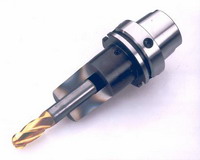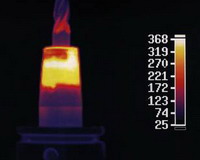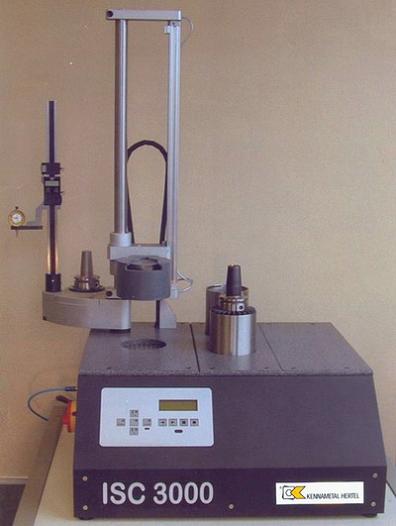When machining at a spindle speed of 15,000 r/min or more, one may find that there are more problems to be faced: imbalance, vibration, and radial runout. These are the tools. Shortevity, poor surface quality, and potential for spindle failure. The tool holder selection error is undoubtedly meant to be troublesome for the user.
Now, people have to face the fact that the machine speed is constantly increasing. In particular, the need for lightweight vehicles makes aluminum alloy workpieces more widely used for high-speed machining. The high throughput of high-speed machining also benefits engine manufacturers, powertrain components, and manufacturers of dies and molds. At the same time, HSM has made lightweight manufacturing a reality and more reliable.
For high speed machining, the impact of toolholders on production reliability, machining accuracy and total cost effects is especially important. The tool holder must be smooth or easy to smooth and must have sufficient clamping force to be sufficient for the production of the shop and for a wide variety of cutting tools. 
Kenner's heat shrinkable shank 
Heat shrinking heating 
Kenner's heat shrinkable clamping machine
The latest trend in tool clamping technology is the use of a heat-shrinkable clamping structure that uses an induction or hot air heating to expand the toolholder hole for tool change, and then air-cools the tool to room temperature, using the toolholder hole and tool The outer diameter of the interference fit clamping, this structure allows the tool to maintain reliable clamping performance at high speeds, especially for higher speed high speed milling.
The system seems to have a convincing design philosophy for high speed machining. Due to their symmetry and lack of moving parts (such as screws), they are inherently balanced, with radial runouts between 2.5 and 5.0 mm or less, and provide considerable clamping force. According to estimates by Briline Tooling Systems, when the mast rotates the tool at 75 kW, the heat-shrinkable toolholder provides an average clamping force of 44.5 kN for the taper shank. The company claims that its clamping capacity is more than five times higher than the clamping force of mechanical or hydraulic jaws.
However, the use of heat-shrinkable toolholders is very slow, and the reasons for the analysis may be as follows: First, the installation concept using the principle of thermal expansion and contraction is not acceptable. Some people lack sensitivity to the way they do not use fixing screws or jaws to clamp objects. Plus, the tapered taper shank must have a matching taper shank diameter, so for tools of different sizes. It does not seem to be very flexible when used. However, in the production of large quantities of automotive parts, this is not a major problem, because the taper shanks that people usually use are standard. Although the tool change time can be shortened, the time required for this process is even less than 30s, but some people still have a negative attitude due to the heating and cooling process.
In addition, the cost issue is also a consideration. Toolholders with heat-shrinkable clamping structures cost approximately 30% more than other toolholders, and an induction heating unit is required, ranging in cost from a few thousand dollars to more than $10,000. But all users who come into contact with the hot-shrinking tool holders believe that the performance of the heat-shrinkable tool holders in practice proves that they do have sufficient rationality, and the advantages of high-speed machining or low-speed machining are obvious. This can be seen by comparison with a toolholder that uses hydraulic clamping or other mechanical means. These advantages are ultimately reflected in cutting tool life and high-speed machining productivity. Accelerated feed rates and lower tool consumption compensate for the cost of using heat-shrinkable clamps.
In the long-term perspective, if a factory invests a large amount of money on the purchase of tools every month, the use of heat-shrinkable tool holders can effectively reduce manufacturing costs. Aisin Drivetrain has tested heat-shrinkable toolholders in the production of its gearboxes, with speeds and feed rates increased by 20% to 30%, productivity increased to 400%, and PCD tool life increased by a factor of 3. While saving the cost of expensive tool input, the rationality of the heat-shrinkable clamping structure has also been proved.
At the same time, the elastic jacketed tool holder has not stopped for the pursuit of high speed. As the most popular tool holders, they rely on a purely mechanical interface to clamp the tool, adapting to a wide range of pedicle lengths and diameters, and have long been able to provide users with a high degree of comfort and flexibility. At present, at least a number of suppliers have the ability to provide flexible jacketed toolholders for high speed machining.
The elastic jacketed tool holder has many practical advantages. Many users say that they prefer a gripping method that does not require heating, so that it is safer for the average operator to use. The elastomeric jacketed toolholder allows for more tool pre-adjustment in the Z-axis. For heat shrinkable tool holders, a proprietary pre-conditioner is required to achieve this. Especially for the majority of users in the automotive industry, they prefer the Z-axis pre-adjustment capability, which makes it easy to change tools.
The flexible jacketed tool holder is flexible. When replacing a tool with a taper shank of different diameters, it is only necessary to replace the jacket instead of the entire toolholder. However, the price of flexibility is that there is a lack of rigidity when clamping a particular tool, which results in a large wear of the blade and requires frequent tool changes.
Rego-Fix claims that it has a powerful finishing system that rivals heat-shrinkable toolholders. The company's powRgrip powerful finishing system, introduced in 2004, produces a large clamping force through an extreme interface between the jacket and the shank. Multiple tool changes indicate that the system performs well and the system is said to have passed more than 20,000 tool insertion and removal test records. The only wear piece on the chuck is the jacket, which is a relatively inexpensive spare. Similar to the heat shrink system, powRgrip also requires a tool insertion mechanism. The mechanism is a bench-top mini press that produces 6t of pressure and takes about 15 seconds to insert or remove the tool.
Lyndex-Nikken also offers a high-speed, flexible jacketed toolholder system. It is said that its VC-type toolholder is especially suitable for the trimming of die/die, running smoothly at a high speed of 40,000 r/min, and the radial runout is only 3 mm at 4×D. In addition, the tool holder does not require the use of tools or clamps to disassemble the jacket. According to Lyndex-Nikken, various features make the tool holder still have a very high precision at 40,000 r/min. The jacket has a shoulder with a long handle and a flat shoulder that ensures concentricity and reasonable force transmission. In addition, the smooth shape of the tool holder also reduces air flow and cutting noise during high speed machining. Through the intrinsic features, such as the thick-walled portion of the base and the 8° jacket design, the resonance is suppressed and the rigidity is increased. Because vibration can shorten tool life, reduce surface accuracy, and wear the spindle, the system's ability to absorb and isolate vibration during high-speed machining is quite valuable, and it is superior to heat-shrinkable toolholders in suppressing vibration. In addition, the VC tool holder also features a TiN coating that reduces friction when tightening the nut, so larger torques can be used, while the grooves under the nut can suppress small resonances.
Another high-speed chuck holder can also be balanced at a high speed of 40,000 r/min, which was launched by BIG Kaiser Precision Tooling in September 2004. The BIG-PLUS two-sided positioning spindle system is currently the only 7:24 taper shank in the world that can truly achieve "two-sided positioning". The use of the Mega chuck system with the BIG-PLUS two-sided positioning spindle system improves the accuracy and rigidity of the spindle and toolholder contact surfaces. It has been reported that unslotted nuts eliminate tool vibration, reduce howling and reduce coolant splash at high speeds. The tool holder has a unique set of ball bearing one-way clutch system as a ratchet when the nut is tightened. This series of toolholders is designed for the smallest tools and has four different sizes ranging from 0.25 to 38 mm: Mega miniature elastomeric jacket for compact areas of small cutting tools; standard New Baby collet for high speed machining E-type collet for face milling with a high clamping force of up to 12.7 mm; and a dual-powered chuck with double-contact nut between the tool holder and the nut for increased rigidity.
Regardless of the tool holder used, balancing is critical for high speed machining. In high-speed machining, the generally accepted maximum unbalance of the tool holder is 3g-mm, but when the spindle moves at a high speed of more than 30,000r/min, the unbalance amount drops to 1 g-mm. It has been found by comparison that the standard and common face milling cutter clamps can exhibit an unbalanced amount of 250 g-mm. This imbalance can lead to catastrophic failure depending on the actual speed of use.
In order to be suitable for high speed machining, some toolholders are pre-leveled to a specified level. Some pre-aligned toolholder suppliers also offer balancing equipment. These devices allow the user to balance the toolholder system for optimal use and reduce wear and tear caused by unbalanced centrifugal forces at high speeds.
Even with pre-adjustment, poor alignment of the spindle, damage and wear of the tool, and loose fitting tolerances on the components may compromise the balance in the process. Therefore, it is important to maintain the balance of the tool holders in the workshop. Rego-Fix offers a toolholder method in which each toolholder is manufactured with a set of grooves and a balance ring can be added when needed. These balances wrap around the pockets into the groove, making any standard tool holder for the Rego-Fix a balanced tool holder. The gimbal structure is effective for speeds in excess of 42,000 r/min. As a tool holder with balance capability, after the tool is replaced, it is also necessary to balance the equipment to balance and inspect these tool holders.
It is important to keep the toolholder system below the imbalance threshold for a given speed. This threshold decreases as the rotational speed increases. If the speed is 30000 r/min or faster, the balance threshold will be reduced so that little vibration is not allowed. In this case, it is recommended that the user use the tool after it has been pre-adjusted and the tool holder system has been balanced. Even at low speeds, it needs to be rebalanced. Especially when changing the retaining shank on different machine tools, when changing or changing the design of the tool between the high speed steel tool and the carbide tool.
Rotary Bintangor Veneer Plywood,Bintangor Plywood,Furniture Plywood Panel
Fushi Wood Co., Ltd. , http://www.sgplywood.com